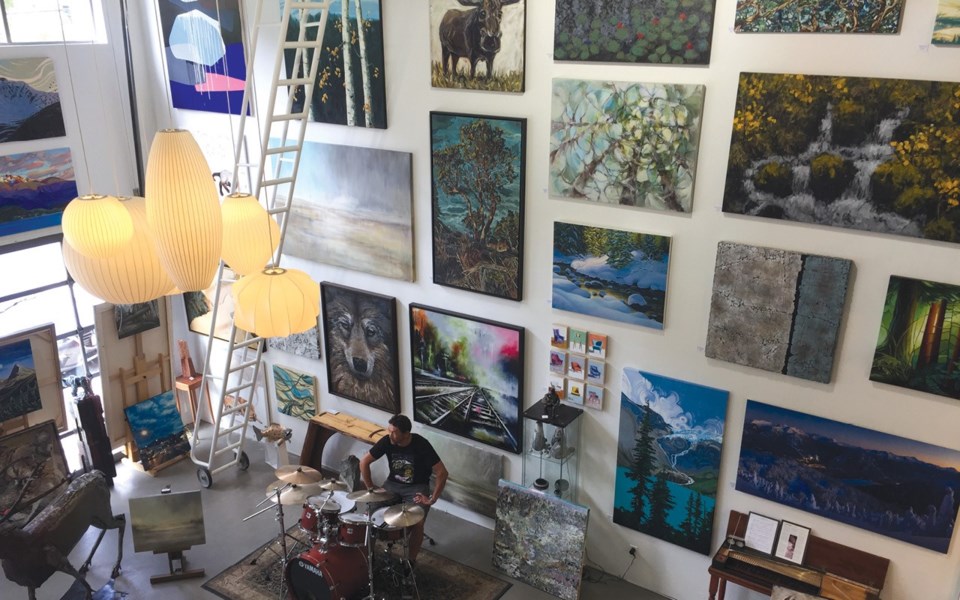Harvey Lim calls a customer to let them know their art is ready for pick-up. Corners and edges safely protected by plastic wrap, the large painting depicts a tropical scene. "It's from Costa Rica," he says. "The canvas was dry as a bone so I moistened the back to 'relax' it a bit before stretching it onto the frame."
That's a trick of the trade, one worth knowing when many of your customers ferry art in various states of repair back from foreign destinations. The kind of thing art curators or conservationists learn in school. Lim, however, claims it as street knowledge.
"I pretty much fell into framing," says the owner of Whistler's Art Junction as he sizes matboard on an upright cutter. His workspace also features a horizontal cutting table and a vacuum heat press for annealing posters to foam. As he flips the mat, there's tape-measuring and number-muttering; fractions figure prominently in a business still conducted in inches.
Like many, Lim's first years in Whistler involved any job he could get. One was working in a picture-framing store. It positioned him for a future baptism by fire.
Working construction, he saw an artist call-out for a new gallery opening in Function Junction. He swung by and told them he was no artist, but thought they should also offer framing because the other business was shuttering. "The owner tossed me his credit card and said 'I'm going to Europe for a month so buy what you need and I'll see you when I get back,' laughs Lim. "I worked for him about five years and then one day he said 'I'm done; why don't you buy it from me?'"
With the seller financing the deal, Lim paid it off in a year. Suddenly, he owned a gallery and framing studio.
Art Junction is a high-ceilinged affair where a diverse spectrum of artists, media and subject matter ascend whitened walls in a virtual study of contemporary Canadian art. In the centre sits a drum set, begging to be pounded; it's not installation art. Sales here run 50-50 between framing and art; abstracts are in vogue because of Whistler's building trend toward modern-style homes. "But art sales are random," notes Lim, "so framing is my full-time work."
Having mounted photographs and college diplomas today, he turns to a gorgeous piece of Mexican paper art. The first challenge is affixing it to the mat without any visual sign, and without compromising the material. Reaching for a "secret agent" toolkit he gets to work, employing the same system he'd use if, for instance, he was mounting an Olympic torch with a track suit, or a sports jersey.
"I've done a lot of team uniforms," he says. "That kind of stuff is fun."
His own hangs behind him—a green-blue-black soccer jersey with gold Chinese characters surrounded by photos, medals, and a pair of gloves. Before he came to Whistler—ages 15 to 28—Lim was a pro "footie" goalie. He started in Norwich, England, and played his last few years in Hong Kong.
Hoisting a 40-by-60-inch (101-by-152-centimetre) piece of glass into the cutter, Lim mentions that soccer goalies are "a couple of sandwiches short of a picnic," before affirming how much he loves his current work. "It's always fun, lots of variety. And I make my own hours," he says of a job that yields time for a young family, ski-touring, and mountain biking. "One hot day last week some friends and I biked up Lord of the Squirrels at 4 a.m. We were down by 10 and I was at work by 11."
Looking ahead to future tasks, Lim unrolls a spectacular photo with a five-figure price tag. "Expensive or rare stuff still makes me nervous," he says. "It's cool I get to see it... but you have to be very careful. It's fun to be challenged when people bring in crazy stuff that you have to figure out how to mount."
His weirdest jobs? "Inca burial dolls. They were old and fragile, totally disintegrating. They made the hairs on the back of my neck stand up. I wore gloves. Oh, and a set of his-and-hers woven dreadlocks. Something was living in them so I used gloves for those, too. One lady brought in a full-length Jean Patou fur coat—that was quite a project."
The commonest? "I've mounted a few dozen Toad Hall posters. And lots of Whistler 40th anniversary and Saudan Couloir race posters."
He places the cut glass into a wooden frame, fitting a foam liner around the inside so that when he drops the mat in the glass sits above—and not on—the art. As a penultimate act, he ensures no dust remains inside and fixes the mat in place with framer's points. Over it goes a paper backing, rubber bump-ons to keep it from swinging on the wall, then hangers about a third of the way down.
It's delicate, tactile work that requires patience, which Lim mostly has. And when he doesn't? "The drums help," he says.
Leslie Anthony is a Whistler-based author, editor, biologist and bon vivant who has never met a mountain he didn't like.




